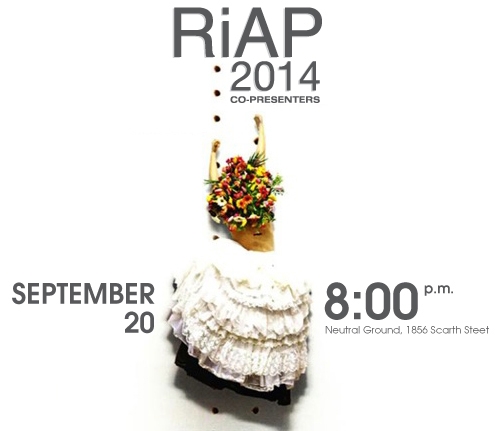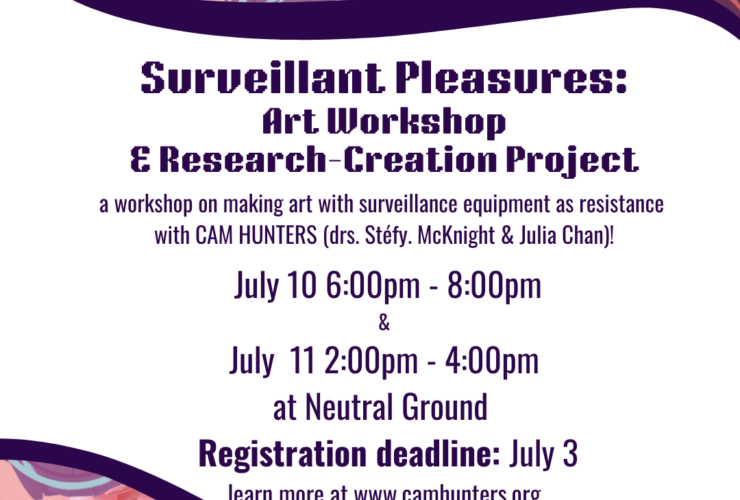Ewa Świdzińska, Aleksandra Ska, Gary Varro, Robin Poitras
Richard Martel (Artistic Director)
September 20, 2014
Neutral Ground is pleased to be one of RiAP’s co-presenters for their 2014 festival.
We will be touring WTF, a new work by Gary Varro, to Quebec City and bringing artists Ewa Świdzińska and Aleksandra Ska to Regina for a Performance on Saturday, September 20th at 8:00 pm at Neutral Ground, 1856 Scarth Street.
Robin Poitras will also be performing at RiAP at the invitation of Richard Martel.
Join us for a Performance Conversational Barbeque on September 19th with Ewa Świdzińska, Aleksandra Ska and Randy Gledhill in attendance at the new studio-garage of Michele Sereda.
Please call (306) 522-7166 for more information.
Events are open to the public, pay what you can at the door.
Intro
TAKING THE PULSE OF LIVING ART DURING TEN DAYS.
The Rencontre international dart performance de Qubec confirms the growing importance of performance art practices with its 18th edition, which also marks the organizations 30th year of activity. From September 11th to 14th and from September 18th to 21st, RiAP 2014 will be inviting 26 artists from Cuba, Norway, the Philippines and Poland, as well as from four different Canadian cities (Calgary, Regina, Victoria and Winnipeg) to perform in the heart of Quebec Citys Saint Roch neighbourhood.
Two weeks of original, surprising and uncompromising artistic activities are in store! Six evenings of performance will be held on the festivals Thursday, Friday and Saturday nights. Each of these evenings will give audiences the chance to peer into the worlds of performers from a different part of the world. On the Sundays, conferences and open discussions will be held, allowing for exchanges and collaborative contemplation. Critics, art theorists and organizers will discuss the differences and parallels between various performative practices. The issues and challenges faced by artists in foreign countries will also be looked at.
For this edition, the RiAP will also be sending the invited artists on tour. Artist centers and cultural organizations from Carleton to Rouyn-Noranda and Regina will be accompanying us in this adventure by receiving artists from the RiAP in their centers.
Richard Martel
Artistic Director
Ewa Świdzińska
Ewa Świdzińska was born in Milanowek, Poland, in 1958. She is a graduate of the Secondary School of Fine Arts in Warsaw and the Institute of Artistic Education in Czestochowa, Poland. She lives in Warsaw.
She works in performance art, video, photography and social-artistic actions, and runs interdisciplinary workshops combining visual arts with other fields such as sociology. Her interest in performance art began in the early 90s. From that time she has participated in many festivals and performance events in Poland and abroad, both in and outside of the white cube (International Festival of Street Art, Warsaw, Poland, Performance Art Festival Ritual in Pedvale, Latvia) and in projects dedicated to womens art (Woman about Woman, Bielsko-Biała, Poland, Performance-esse, Toruń, Poland). She also participated in the program Alphabet of Polish Performance on TVP Kultura.
Świdzińskas performances often refer to the problems of a contemporary woman, her involvement, dilemmas, social and political issues. Their starting point is her own sexuality and experience of being a woman. In her approach, what is private and internal becomes a discourse of culture. Świdzińska picks up on themes of evanescence, freedom, solitude and overcoming taboo. These actions sometimes take the form of a ritual bustling about the body using simple means and gestures. Świdzińska sees her art as a concentrated answer to existing as a woman in a contemporary world, its perceiving and understanding of a complex, ambiguous reality.
Performance is a self-update, performance is me (performance, it is I, performance, cest moi) – this is my first and I think still actual definition. When about 20 years ago I started working on performance art, I was a mature woman. I needed to show myself and performance is the most direct (anthropological) way of giving opinion. It was a kind of compensation, I wanted to call attention to my own experiencing of reality, my problems as a woman and artist. Performance made me feel appreciated, so my motivation for dealing with it was not strictly artistic. It is self-update also in a context of a surrounding reality. The spectator is a witness of the performance artists actual being. He can try to orientate, verbalize, interpret, but not necessarily well if he experiences. Thats why I treat performance more and more formally freely. I introduce narrative space – momentary, discontinuous, as a testimony of the accused in a court or confession on a couch in a psychoanalysts room. Wishing to arrange this torn up set-up of elements as doomed causes some kind of pressure in me and the spectator. I call my actions performances of complement, supplementing (myself?). Now I would add that performance has intensified me. It is a laboratory of myself, in which noises, dirt and surprises are dissected.
Aleksandra Ska
Aleksandra Ska graduated from the Strzemiński Academy of Art in Łdź, Poland, in the Faculty of Textile and Fashion. She lives in Poznań and works at the Szczecin Academy of Art in The Departament of New Media. A creator of installations, objects and videos, her art is related to the subconscious and sexuality. She is interested in corporeality presented through forms of bodily impression. Her creative activity is always filled with elegance, splendour and sensuality. However, Ska introduces to her installations disturbing elements that come from the subconscious and dreams, evoking anxiety or apprehension. Female sexuality is emphasized. The artist treats fetishism as something that seduces, tempts and attracts, not only in a visual sense, but also in haptic way. Sometimes Ska’s works are linked to another sense – that of taste – as is the case in Fat Love, a video installation that was presented in a butcher’s shop in Poznań.
Skas work has been presented at: Hot/Cold Summer Loving, Zachęta National Gallery of Art, Warszawa (2006), Mediations Biennale, Voyage Sentimental, National Museum in Poznań (2008), Collection of Art of the 20th and 21st Centuries, Behind the Reality Principle, Muzeum Sztuki in Łdź (2008) and The Summer of Youth, Young People in Contemporary Art, Zachęta National Gallery of Art, Warszawa (2010). In 2007 she was awarded the Grand Prix at Przeciąg Festival and in 2011 she was the Młoda Sztuka award winner of Głos Wielkopolski in the field of visual arts. She was a Ministry of Culture and National Heritage scholarship holder in 2007, 2011 and 2014. In 2013 she was invited for an artist residency in New York by The Visegrad Group.
Gary Varro
Gary Varro is a curator, visual artist and designer based in Regina, Saskatchewan, where in 1996 he established and continues to present Queer City Cinema Media Arts Festival and more recently Performatorium Festival of Queer Performance. Gary is also a free-lance curator, most recently curating a program for MIXNYC this past November. Since the mid 90’s, his visual art practice has proposed critical relationships with the architectural and social spaces they occupy and reference. He has recently begun to explore the performative side to his work, with a recent residency on Toronto Island and a performance art festival appearance in Vancouver.
Robin Poitras
Robin Poitras is one of Saskatchewan’s most prolific dance and performance creators. Creating dance, performance and installation works, she has been actively engaged in contemporary dance practice since the early 80s. For many years Robin has traversed the formal worlds of dance and performance art. Her practice is rooted in a physical world comprised of choreography, dance and actions/acts. Her work often involves the use of found or formed objects, texts, images, sound and/or other media. She co-founded New Dance Horizons in 1986, where she continues to act as Artistic Director.
Poitras’ performance work belongs to an emergent category of interdisciplinary work informed by the rigor and discipline of dance and the austere, formalist qualities of abstraction and visual art.
She uses these disciplinary points of departure to delve into the social and cultural tropes that are classically contained by myth and mythology or obscured in the vernacular by fairy tales or as dwelling in the dynamics and subterfuge foundations of psychoanalysis. Her work interrogates power and the paradigms of control that belie revolution or upheaval precisely because they operate at levels of unconscious complicity and acceptance.


